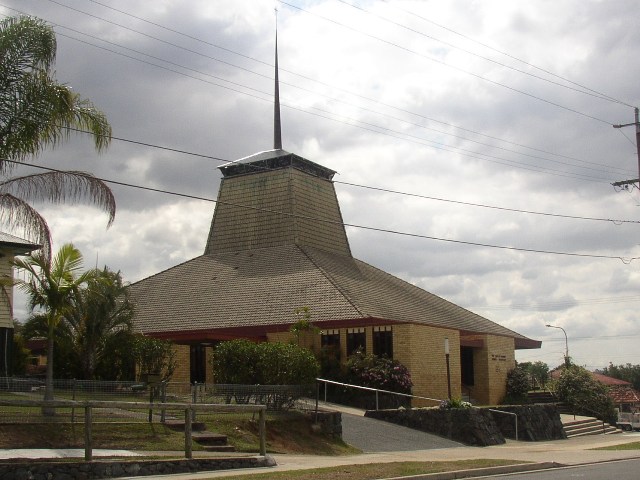Addresses
Type of place
Church
Period
Late 20th Century 1960-1999
Style
Ecclesiastical
Addresses
Type of place
Church
Period
Late 20th Century 1960-1999
Style
Ecclesiastical
Our Lady of Dolours Church was built in 1964 to the design of architects Cullen, Fagg, Hargraves and Mooney. It joined the local presbytery, convent and Catholic school to form a strong Catholic community that established itself as Mitchelton progressed from a predominantly rural area to a more intensively developed suburb in the postwar period. In 1966, its unique design received a commendation in the ‘Building of the Year’ category of the Royal Australian Institute of Architects awards for meritorious architecture.
Lot plan
L1_RP43226; L2_RP43226
Key dates
Local Heritage Place Since —
Date of Citation —
Construction
Roof: Tile;Walls: Face brick
People/associations
Cullen, Fagg, Hargraves and Mooney (Architect)Criterion for listing
(A) Historical; (D) Representative; (E) Aesthetic; (F) Technical; (G) Social; (H) Historical associationInteractive mapping
Lot plan
L1_RP43226; L2_RP43226
Key dates
Local Heritage Place Since —
Date of Citation —
Construction
Roof: Tile;Walls: Face brick
People/associations
Cullen, Fagg, Hargraves and Mooney (Architect)Criterion for listing
(A) Historical; (D) Representative; (E) Aesthetic; (F) Technical; (G) Social; (H) Historical associationInteractive mapping
History
Land upon which the Catholic Church has established the buildings that represent the hub for the local Catholic community was originally part of 13½ acres purchased by William Robinson in 1864. After the land passed to his widow in 1884, James Robinson acquired title to the property in 1892. This farmer of Dingo Head, Teleman Crossing Upper Logan, retained the property until it was transferred to the War Service Homes Commission in the late 1920s.
At this time Gaythorne / Mitchelton was beginning to become more densely settled. The train line to Enoggera had been operating since 1899 and extended to Gaythorne (initially Rifle Range) in 1916 and Mitchelton in 1918. The Rifle Range, from which originated Gallipoli Barracks, was officially established in 1908. With the advent of World War One (1914-18) the Range became a recruit training area as well as a staging camp. Military personnel and their families contributed to the population growth in the adjoining suburbs. Residential estates such as Lade’s Paddock, the Brookside estate and Oxford Park estate were offered for sale in the first two decades of the twentieth century. Population growth in the area warranted the establishment of the Enoggera (originally called Grovely) State School in 1916.
At this time Catholics in the developing local community travelled mostly to Alderley to the first St John the Baptist church (built 1908) to receive the sacraments, and during the 1920s also worshipped at the chapel of the Redemptorist Order of monks in Church Road. James Duhig, Catholic Archbishop of Brisbane bought the 3 subdivisions on the corner of Samford Road and Suez Street from the War Service Homes Commission in May 1928. The first Church of Our Lady of Dolours was produced by transforming the house on the corner of the site when it was purchased. At the opening ceremony on Easter Sunday, 19 April 1930, Archbishop Duhig commented that the drive to Mitchelton had become familiar “during the sad days of the Great War … when our soldiers were being trained for overseas in that big area that surrounded the White City”. From being “scarcely more than a name” Mitchelton then was becoming “one of our most rapidly growing suburbs” with “its picturesque slopes and hill-tops now being covered with beautiful villas”. By June 1941, when the Mitchelton Presbytery was completed and blessed, there were about 140 Catholics in the parish. During World War II the Mitchelton parish priest ministered to the needs of the parish as well as carrying out duties as an Army chaplain and chaplain to the nearby Good Shepherd Convent.
The parish priest of the time (1960s), Father Nugent, had travelled overseas and did extensive research to try to ascertain what the changes might be. He told the architect that he wanted a “church that could be seen from all over the parish” and had “the congregation … as close as possible to the altar”. The accepted design produced by Hargraves had the altar sited so the priest could stand either in front or behind it. The new church, designed by architectural firm Cullen, Fagg, Hargraves and Mooney, opened in 1964.
The church received a commendation in the ‘Building of the Year’ category of the 1966 Royal Australian Institute of Architects awards for Meritorious Architecture. It was built at a time of significant changes to liturgical practices introduced by the Vatican Council in Rome and may have been one of the first churches in Australia to have a free-standing altar. Our Lady of Dolours was certainly the first church built in Brisbane and probably Queensland to provide for changes in the liturgy and is one of the earliest churches in Brisbane to have the congregation’s pews arrayed around the altar. The church is also a War Memorial “commemorating all Australian Servicemen … fallen in the war”.
Statement of significance
Relevant assessment criteria
This is a place of local heritage significance and meets one or more of the local heritage criteria under the Heritage planning scheme policy of the Brisbane City Plan 2014. It is significant because:
References
-
Our Lady of Dolours. Parish Jubilee 1932-1982. Publication held in Catholic Archives
-
‘New Mitchelton Church opened’, The Catholic Leader, 22 July 1965, p.3
-
‘Church with a “new look”’, Courier-Mail, 19 July 1965, p.7
-
‘New presbytery at Mitchelton’, The Catholic Leader, 26 June 1941, p.10
-
‘Thirty-Fourth place of Worship’, The Catholic Leader, 24 April 1930, p.21
-
‘A Pocket Guide to RAIA Awards in Brisbane 1933?-1997’, working draft
Citation prepared by — Brisbane City Council (page revised June 2022)

